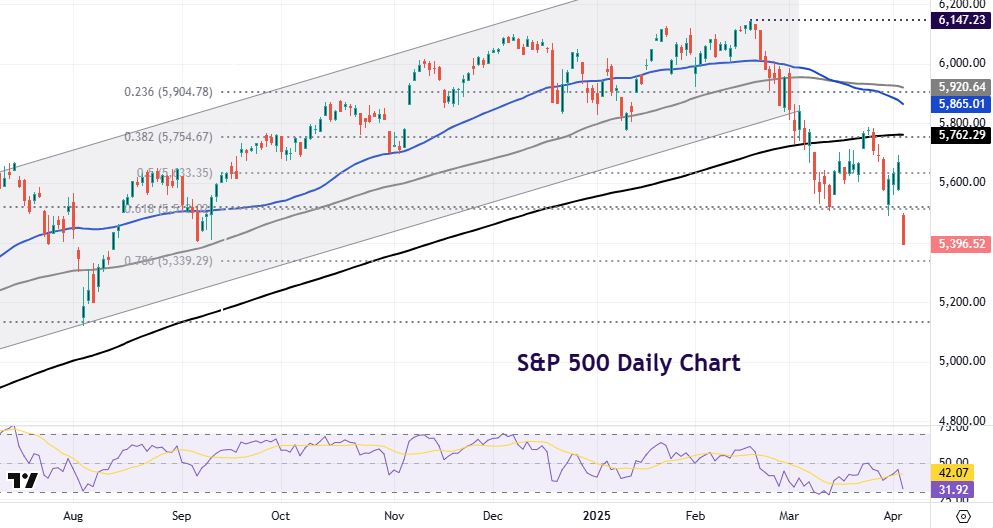Stocks and USD crater after Liberation Day shock

- Wall Street crumbled with biggest one-day falls on all three stock indices since 2020
- The VIX, the volatility gauge, closed above 30 for the first time since August
- Apple suffered its worst in five days down 9.2% after an aggregate 54% China levy
- The dollar fell sharply as investors grapple with tariff aftermath
FX: USD tumbled as the full impact of the tariff announcement and Liberation Day hit markets. A meaningful slowdown is expected in the US with an increased amount of Fed easing being priced in. Deeper pessimism about US domestic demand means markets are focusing on the “stag” part of stagflation, and not the “(in)flation” part. Traders now price in 91bps of Fed easing in 2025 (previously around 70bps). Big support lies at the December 2023 and September 2024 lows around 100.60 and just below.
EUR jumped above 1.11 at one point before pulling back through the US session. Markets digested the imposition of a 20% tariff rate on imports from the European Union. European officials have not responded with countermeasures and remain open to negotiation. The Spanish PM asked the European Commission for reinforcement of trade links with the rest of the world. French President Macron called on big European businesses to freeze all investments in the US in relation to the US tariffs.
GBP broke decisively higher to a high at 1.3207 before paring gains and being the biggest major underperformer versus the dollar. The UK was relatively spared with 10% tariffs and negotiations ongoing. A minor Fib level resides at 1.3148 as resistance.
USD/JPY was the second strongest major after the swissie, supported by the broader market tone and a narrowing of the Fed/BoJ outlook. The 10-year US Treasury plunged to 4.03%, a six-month low, as money markets fully priced in a June FOMC quarter-point rate cut.
AUD made gains of just 0.5% on the day, so was actually one of the laggards versus the dollar, even though Australia appeared to be spared with tariffs of only 10%. CAD was also a relative underperformer, although slightly better than the aussie. The major hit levels last seen in December, but existing tariffs remain in place.
US stocks: The S&P 500 lost 4.84% to settle at 5,397. The tech-heavy Nasdaq finished down 5.41% at 18,521. The Dow closed 3.98% lower at 40,546.
- A combined $2.4 trillion in stock market value was knocked off S&P 500 companies. The Dow had its worst one day drop since June 2020, the Nasdaq since the pandemic in March 2020.
- The only sector in the green was consumer staples, with energy down 7.5%, tech off 6.9% and consumer discretionary lower by 6.45%.
- One equity analyst said the Trump tariff announcement was “worse than the worst-case scenario” for Wall Street, and tech stocks like Apple and Nvidia will face “major pressure”. Those stocks ended down 9.25% and 7.81% respectively.
- Retailers were also hit very hard with Nike and Ralph Lauren plunging 14.4% and 16.3% after heavy tariffs on major production hubs in Vietnam and Indonesia.
Asian stocks: Futures are in the red. APAC stocks mostly tumbled in the aftermath of the ‘Liberation Day’ tariff announcements. With the actual baseline at 10%, many Asian countries were hit much higher, as they were deemed to have been cheating America the most.
- The ASX 200 was dragged lower by underperformance in tech and energy. Australian PM Albanese said they will not impose reciprocal tariffs and will continue to make the case for these unjustified tariffs to be removed from exporters.
- The Nikkei 225 suffered heavy losses with the index firmly beneath the 35,000 level. US President Trump announced 24% tariffs for Japan, while there were notable losses seen in the financial sector and automakers after they were also hit by the 25% auto tariffs.
- The Hang Seng and Shanghai Comp were pressured after Trump imposed a 34% tariff on China, on top of the existing 20% tariffs, for a total 54% tariff rate. The Hong Kong benchmark conformed to the broad regional selling, though the mainland initially showed some resilience The downside was modestly cushioned after stronger-than-expected Caixin Services PMI data.
Gold dropped sharply through the Asian and European sessions after making another record high at $3167, The precious metal then found a bid in US hours. The low of the day was $3053 but the intraday rebound still left prices outside the long-term bull channel, so overbought. Profit taking and margin calls is the likely reason for the dip as investors have to deleverage. Some of the tariff-fear premium was also likely unwound as bullion avoided any trade tariffs.
Day Ahead – US Non-Farm Payrolls
Amid all the volatility around tariffs and trade wars, it’s the first Friday of the month which invariably means we get the release of the US monthly employment report. Consensus sees 128k jobs added, down from the prior 151k. An inline print would be below the current three-month average at 200k and the twelve-month average pace at 162k. The range of analyst estimates sits at +80k to +185k. The unemployment rate is predicted to tick up one-tenth to 4.2%. Wage growth is predicted to come in at 0.3% m/m and 4% y/y.
A modest decline in federal government employment is forecast, but most of the effects of Elon Musk’s DOGE cuts are likely still ahead as reductions are staggered. There could be a mildly positive strike rebound effect, while initial jobless claims were little changed between reference weeks and business surveys were on net positive for hiring and growth. We note March is normally a significant up-month for seasonally unadjusted job gains.
Chart of the Day – S&P 500 plunges with more to come
The plunge after the historic tariffs announcements has now wiped out more than the post-election S&P 500 rally until early February. Yesterday saw the blue-chip S&P 500 suffer its biggest daily decline since June 2020. There are many ways to understand how tariffs will impact the US economy and the stock market. Effective tariffs could reach 22% versus 3% at the start of the year. That raises inflation risks. One major investment bank sees a “high risk” of the US economy falling into a recession this year. It expects 2025 US GDP growth to contract 0.1% q/q, while Goldman Sachs suggested the latest US tariffs would further drag China’s GDP growth by around 1%, taking the total drag to 1.7%. Consumption and business investment and margins will suffer, bringing an increased risk of recession, while fiscal deficits will widen.
A shift in leadership in the benchmark S&P 500 has also taken place in the previous few weeks. Portfolios dominated by growth stocks has switched to higher cyclical ownership via defensive sectors. That has meant a move into large-cap value stocks. They enjoyed their best first quarter since the dotcom bubble in 2001 and we saw this performance again with just one defensive sector in positive territory amid the carnage on Wall Street.
On the chart, prices closed very near to their lows of the day, at 5,390, which is a bearish sign. Strong support now becomes resistance above, at around the previous lows and two Fib levels at 5,510/20. The index needs to get back above 5,700 to stop the downtrend. Otherwise, the next near-term support is 5,339 and long-term Fib and the August bottom below there at 5,119.

